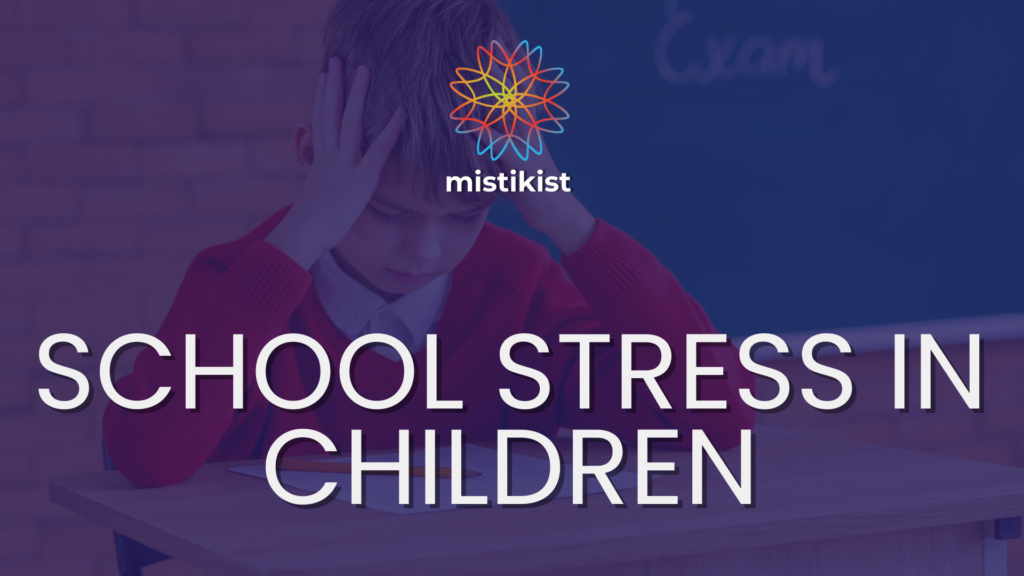Understanding and Addressing School Stress in Children
Introduction
School stress is an increasingly common issue among children and adolescents, starting as early as kindergarten and continuing through high school. This pressure to perform, excel, and fit into social norms can overwhelm young minds, leading to a host of emotional, physical, and behavioral problems. This blog post delves into the nature of school stress, its sources, the signs that parents should look out for, and practical strategies for alleviating it.
The Nature of School Stress
Stress is a natural part of life, and in moderation, it can be beneficial. It motivates us to tackle challenges, learn new skills, and grow. However, when stress becomes chronic or overwhelming, it can have detrimental effects, especially on children. Unlike adults, who may have developed coping mechanisms over time, children are still learning how to manage their emotions and navigate complex social and academic landscapes. When school stress goes unchecked, it can interfere with their development, impair their ability to learn, and negatively affect their mental and physical health.
The Sources of School Stress
School stress can originate from various sources, each contributing to the overall burden that children face daily. Understanding these sources is crucial for parents, educators, and caregivers who wish to help children manage and reduce their stress levels.
- Academic Pressure: One of the most significant contributors to school stress is academic pressure. From a young age, children are taught that success in school is paramount. This emphasis on academic achievement can turn the joy of learning into a struggle to excel, where children feel their worth is tied to their grades and test scores. The pressure to perform well in school often leads to excessive homework, intense study sessions, and a fear of failure that can be paralyzing.
- Social Dynamics: Navigating social relationships is another significant stressor for children, particularly as they enter middle and high school. The desire to fit in, make friends, and avoid bullying or social rejection can create immense pressure. Social stress can manifest in various forms, such as peer pressure, cyberbullying, and the struggle to maintain or build friendships. For many children, the fear of not being accepted by their peers can be as stressful as academic challenges.
- Parental Expectations: Parental expectations play a critical role in shaping a child’s experience of school stress. While parents naturally want their children to succeed, unrealistic or excessive demands can exacerbate stress. Some parents may push their children towards sustained excellence, often forgetting that such standards are difficult to maintain consistently. When children feel they must constantly meet their parents’ high expectations, they may experience anxiety, fear of disappointment, and a lack of self-worth.
- Environmental Factors: The physical and emotional environment of a school can also contribute to stress. Overcrowded classrooms, inadequate resources, and high noise levels can make it difficult for children to focus and learn effectively. Moreover, the emotional climate set by teachers—whether supportive or strict—can influence how children perceive and handle stress. A positive, nurturing environment can help mitigate stress, while a negative one can exacerbate it.
Recognizing the Signs of School Stress
Children may not always express their stress verbally, making it essential for parents and educators to recognize the signs. These can manifest in various ways:
1. Emotional Symptoms
- Anxiety and Panic: Children may feel constant worry, experience panic attacks, or exhibit nervous behavior.
- Mood Swings: Unexplained changes in mood, such as sudden anger or sadness, can be a sign of stress.
- Depression: Prolonged sadness, withdrawal from activities, and a lack of interest in things they once enjoyed may indicate deeper stress issues.
2. Cognitive Symptoms
- Low Focus and Concentration: Stress can impair a child’s ability to concentrate on schoolwork or other activities.
- Forgetfulness: Children under stress may struggle with memory, often forgetting assignments or misplacing items.
- Negative Self-Talk: A child who constantly doubts their abilities or fears failure may be experiencing significant stress.
3. Physical Symptoms
- Headaches and Stomachaches: These are common physical manifestations of stress in children.
- Sleep Disturbances: Stress can lead to trouble falling or staying asleep, as well as nightmares.
- Fatigue: Chronic stress can leave children feeling tired and drained, even after adequate rest.
4. Behavioral Symptoms
- Aggression or Outbursts: Some children may react to stress with anger or defiance.
- Withdrawal: A child may isolate themselves from friends and family, avoiding social interactions.
- Regression: Younger children might revert to earlier behaviors, such as bedwetting or thumb-sucking, as a way to cope with stress.
Strategies for Alleviating School Stress
While the presence of stress in a child’s life is inevitable, there are numerous strategies that parents and caregivers can employ to help children manage and reduce the School Stress in Children:
- Open Communication: One of the most powerful tools in combating school stress is open and honest communication. Parents should create an environment where children feel safe to express their worries and fears without judgment. Instead of offering solutions or dismissing their concerns, parents should practice active listening, acknowledging their child’s feelings and validating their experiences. This approach helps children feel understood and supported.
- Positive Reinforcement: Instead of focusing solely on outcomes, such as grades or test scores, parents should emphasize effort and personal growth. Praising children for their hard work, creativity, and perseverance can help build their intrinsic motivation and reduce the pressure to achieve external rewards. Encouraging children to take pride in their achievements, no matter how small, fosters a positive self-image and a healthier attitude towards challenges.
- Establishing Routines: Routine is a powerful tool for reducing stress in children. A predictable daily schedule provides a sense of security and helps children manage their time effectively. Parents should establish regular routines for homework, bedtime, and meals, which can help alleviate the chaos that often accompanies school days. Family meetings can also be a valuable tool for discussing the week’s schedule, addressing any concerns, and ensuring everyone is on the same page.
- Encouraging Physical Activity: Physical activity is a natural stress reliever and an essential component of a healthy lifestyle. Encouraging children to participate in non-competitive physical activities, such as biking, swimming, or playing at the park, can help them release built-up tension and improve their mood. These activities should be enjoyable and free from the pressure to compete, allowing children to relax and have fun.
- Promoting Hobbies and Interests: Hobbies and personal interests offer a vital outlet for stress and a way for children to express themselves creatively. Parents should ensure that their children have time to engage in activities they love, whether it’s drawing, reading, playing an instrument, or engaging in a sport. These hobbies can provide a sense of accomplishment and a break from the pressures of school.
- Setting Realistic Expectations: Parents should be mindful of the expectations they set for their children. While it’s important to encourage children to strive for success, these expectations should be realistic and attainable. Parents should recognize that excellence is not always sustainable and that it’s okay for children to have setbacks. By setting achievable goals and celebrating progress, parents can help reduce the pressure on their children to be perfect.
- Seeking Professional Help: If a child’s stress becomes overwhelming or leads to significant behavioral changes, it may be necessary to seek professional help. Child psychologists or counselors can provide valuable support and strategies for managing stress. Early intervention can prevent stress from escalating into more serious mental health issues, such as anxiety or depression.
Conclusion
School stress is a pervasive issue that affects children at every stage of their education. From the pressure to achieve academically to the complexities of social relationships, children today face numerous challenges that can lead to significant stress. However, by recognizing the signs of stress and employing effective strategies, parents and caregivers can help children navigate these challenges and develop resilience. The key lies in open communication, positive reinforcement, and creating a supportive environment where children feel valued for who they are, not just for what they achieve. By taking these steps, we can ensure that our children grow up to be healthy, confident, and well-adjusted individuals, capable of handling the stresses of life with grace and strength.
For more information, visit our website and follow us on social media:
Learn more about Mistikist










